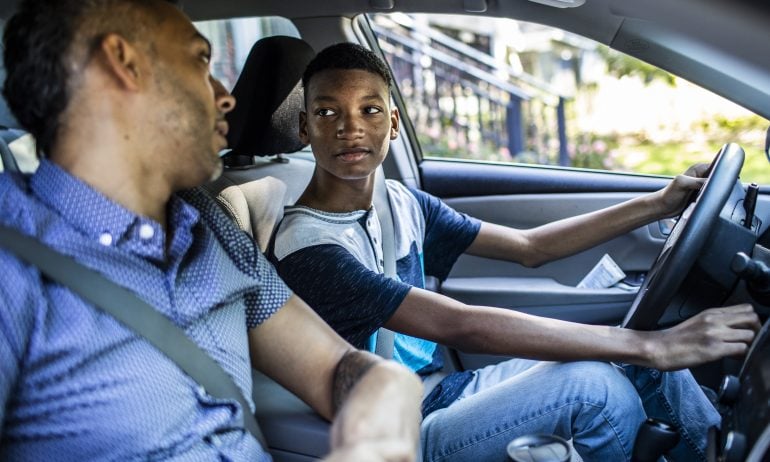Car Insurance for Teens and Young Drivers
Car insurance for teens and young drivers can be expensive. There are ways to save, but the cheapest option is to be included on a parent’s or guardian's policy.

Many, or all, of the products featured on this page are from our advertising partners who compensate us when you take certain actions on our website or click to take an action on their website. However, this does not influence our evaluations. Our opinions are our own. Here is a list of our partners and here's how we make money.
The average cost of adding a 16-year-old driver to a full coverage policy is $3,824 per year.
The best way to get the cheapest car insurance for young drivers is often adding them to a parent’s or guardian’s policy.
Discounts tailored toward young drivers can make paying for car insurance for teens more affordable.
The average cost of adding a 16-year-old driver to a full coverage policy is $3,824 per year.
The best way to get the cheapest car insurance for young drivers is often adding them to a parent’s or guardian’s policy.
Discounts tailored toward young drivers can make paying for car insurance for teens more affordable.
Finding the cheapest car insurance for teens and young drivers can be difficult. Since teenagers are inexperienced drivers, they’re considered very risky to insure, and policies can cost thousands of dollars a year.
It’s usually a lot cheaper to add a young driver to a parent's or guardian’s auto insurance policy than it is to purchase a separate one. And the best way to find the cheapest coverage is to shop around and get quotes from multiple companies.

See what you could save on car insurance
Easily compare personalized rates to see how much switching car insurance could save you.To give you an idea of how much car insurance costs for young drivers, NerdWallet looked at rates for households that add a teen or young driver to their policy.
The best car insurance for young drivers
The best car insurance option for a teen or young driver is typically being added to a parent's or guardian’s policy. That’s because adding a teen or young driver to a household’s insurance policy is often cheaper than getting them a stand-alone policy. Young drivers are seen as risky to insure due to their lack of driving experience and a higher likelihood of reckless driving and accidents.
Adding a young driver to your policy may make you qualify for more discounts. For example, many insurers offer discounts for insuring multiple cars under the same policy. You might also save if your teen is a good student or practices safe driving.
In some rare instances, adding a teen or young driver to an already existing policy isn’t the cheapest option. For example, if you own an expensive sports car that the teen won’t drive, it’s probably cheaper to get them their own policy.
Cost of car insurance for teens
Our analysis found that adding a teen to a two-adult policy more than doubles the cost of auto insurance. The average cost of adding a teenager to a car insurance policy is $3,824 per year, according to NerdWallet’s analysis of full coverage rates for 16-year-old drivers included on a two-parent or guardian auto insurance policy.
Teenage car insurance is so expensive because, mile for mile, teen drivers get into car crashes four times as often as drivers 20 and older, according to data from the Insurance Institute for Highway Safety. Further, car accidents are the leading cause of death for teenagers in the U.S., according to the Centers for Disease Control and Prevention. Additionally, teens typically lack a credit history, are unmarried and haven't completed as much education — all of which can increase car insurance rates.
That all translates to higher insurance costs for teens, but how much depends on factors like the state where the teen lives, their gender and age, and whether the teen is the primary policyholder.
Car insurance cost for teens in a two-adult household
Below are average car insurance rates for policies with two adults and a teen driver. We looked at rates for teens driving their own older car compared to teen drivers that share a family car.
Age | Average annual rate, teen drives an older car | Average annual rate, teen shares a family car |
|---|---|---|
16 | $5,941 | $6,535 |
17 | $5,301 | $5,686 |
18 | $5,023 | $5,239 |
For comparison, the average cost to insure two adults is $2,711 per year, according to our analysis of full coverage rates for a 50-year-old male driver and 45-year-old female driver sharing one policy. | ||
As teens grow older and gain more experience on the road, their insurance costs tend to go down. Two-parent households insuring a 16-year-old pay at least 18% more, on average, than those insuring an 18-year-old.
Car insurance cost for teens in a one-adult household
Below are average car insurance rates for policies with one adult and a teen driver. We looked at rates for teens driving their own older car compared to teen drivers that share a family car.
Age | Average annual rate, teen drives an older car | Average annual rate, teen shares a family car |
|---|---|---|
16 | $4,486 | $2,134 |
17 | $3,956 | $1,833 |
18 | $3,675 | $1,671 |
For comparison, the average cost to insure one adult is $1,794 per year, according to our analysis of full coverage rates for a 50-year-old male driver. | ||
A single-parent household insuring a 16-year-old would pay at least 22% more, on average, than one insuring an 18-year-old.
Car insurance for teens based on gender
Young women can pay a lot for car insurance, but in general, young men see some of the highest auto insurance rates among people with clean driving records. In part, that’s because they are inexperienced and don't have a driving record for insurers to use to set rates.
When insurance companies can’t reference a driving record to determine how likely you are to file a claim, they rely on statistics to gauge risk and set prices. A newly licensed teenager receives high insurance quotes because his peers file a lot of claims, more expensive claims or both.
Male teenagers cause crashes at higher rates than any other group. Teens ages 16 to 19 cause nearly three times as many fatal accidents as adults 20 and older, according to data from the Insurance Institute for Highway Safety. Teenage boys caused roughly two-thirds of those crashes in recent years, down from 75% in 1975, the data shows.
Below are average full coverage rates for car insurance policies with two adults and a teen driver, with the teenager sharing an adult’s car.
Car insurance rates for policies with teens, based on gender
Gender | 16-year-old | 17-year-old | 18-year-old |
|---|---|---|---|
Female | $7,203 | $6,095 | $5,683 |
Male | $8,161 | $6,918 | $6,458 |
Policies with two adults and a male teen driver cost up to 14% more on average than those with a female driver of the same age.
How to save on car insurance for teens
The best way to save on teenage car insurance is to add them to a parent or guardian’s policy instead of buying their own policy. You should also shop around for multiple car insurance quotes to find the cheapest rate.
When shopping for car insurance, be on the lookout for possible discounts, including:
Good grade discount. Some auto insurers offer discounts for maintaining a high GPA or getting straight A's.
Defensive driving discount. If a young driver takes a defensive driving course, some car insurance companies may offer a discount.
Tracked driving behavior programs
Student away-at-school discount. Young drivers who go to school away from home could qualify for a student-away discount.
It’s also cheaper having a teen or young driver share a car with a parent or guardian than having them drive a car of their own, according to our analysis. In addition to saving what you’d pay for an additional vehicle, having fewer cars on a policy means a lower premium.
NerdWallet analyzed rates based on public filings obtained by pricing analytics company Quadrant Information Services. We examined rates for male and female high-school students for all ZIP codes in all of the 50 states and Washington, D.C. Although it’s one of the largest insurers in the country, Liberty Mutual is not included in our rates analysis due to a lack of publicly available information.
All rates we analyzed pertained to “good drivers,” meaning they had no moving violations on record. Our “good” and “poor” credit rates are based on credit score approximations and do not account for proprietary scoring criteria used by insurance providers.
In our analysis, “teen” profiles include drivers ages 16 to 18 who are currently attending high school. We worked under the assumption that the drivers for these teen profiles would have no credit history. Some profiles we analyzed had good student and student out of state discounts.
For a single-parent household, we used a 50-year-old male “good driver” with good credit driving a 2020 Toyota Camry L with full coverage as the parent or guardian profile.
For a two-parent household, we used a 50-year-old male “good driver” with good credit driving a 2020 Toyota Camry L with full coverage and a 45-year-old female “good driver” with good credit driving a 2017 Toyota RAV4 with full coverage as the parent or guardian profiles.
When a young driver drives their own car, we used rates for a 2010 Toyota Camry L insured up to the driver’s state’s minimum coverage requirements.
When a young driver shares a family car, the teen is driving one of the parents’ cars, with the assumption that the teen only has access to the car up to 20% of the time, and the primary driver is a parent or guardian.
These are median rates, and your rate will vary based on your personal details, state and insurance provider.
Sample drivers with “full coverage” policies had the following coverage limits:
$100,000 bodily injury liability coverage per person.
$300,000 bodily injury liability coverage per crash.
$50,000 property damage liability coverage per crash.
$100,000 uninsured motorist bodily injury coverage per person.
$300,000 uninsured motorist bodily injury coverage per crash.
Collision coverage with $1,000 deductible.
Comprehensive coverage with $1,000 deductible.
In states where required, minimum additional coverages were added.
For drivers with minimum coverage, we adjusted the numbers above to reflect only the minimum coverage required by law in the state.
These are rates generated through Quadrant Information Services. Your own rates will be different.

